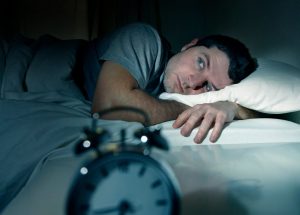Sleep apnea & insomnia: is there a connection?
January 21, 2017

Two of the most common sleep disorders that Americans suffer from are obstructive sleep apnea and insomnia. Several independent studies by medical professionals and sleep specialists have shown that there is a strong correlation between the two conditions. Understanding this relationship is key to treating and relieving sufferers of the symptoms and risks associated with each.
What is obstructive sleep apnea (OSA)?
Obstructive sleep apnea (OSA), commonly referred to as sleep apnea, is a sleep breathing disorder that occurs when the airway is partially or completely blocked during sleep. The soft tissues in the back of the throat collapse causing sufferers to temporarily stop breathing for several seconds or longer. The severity of the condition is characterized by the number of apneas (individual instances of cessation of breathing) that a sufferer experiences per hour while sleeping.
Common symptoms of sleep apnea include:
- Loud or persistent snoring
- Lack of focus / inability to concentrate due to fatigue
- Silent pauses in breathing while asleep
- Nighttime gasping, coughing, or choking
- Morning headaches
- Difficulty staying asleep
- Irritability, depression, or mood swings
- Dry mouth or sore throat upon awakening
- Frequent need to urinate during the night
What is insomnia?
Insomnia is a sleep disorder in which the sufferer has difficulty falling and/or staying asleep. The cause of the condition varies per person and can be linked to psychiatric or medical conditions, biological factors, poor sleep habits, or use of sleep inhibiting substances.
Most people suffer short-term or acute insomnia at some point during their lives due to the development of inconsistent bedtime habits, life situations that cause stress or anxiety, or environmental factors such as noise or room temperature. Chronic or long-term insomnia, on the other hand, persists for an extended period of time and is typically the result of an underlying psychiatric or medical condition.
Common symptoms of insomnia include:
- Difficulty falling or staying asleep
- Waking earlier than desired
- Waking unrefreshed
- Daytime fatigue
- Irritability, depression, or mood swings
- Lack of focus / inability to concentrate due to fatigue
- Anxiety about sleeping
- Frequent errors or mistakes during daily activities
What is the connection between the two conditions?
While insomnia and sleep apnea are medically two separate sleep disorders, there is a high percentage of cases in which the two occur simultaneously. Studies have shown that a significant portion (upwards of 50-60%) of people who have been diagnosed with one of the conditions are later found to suffer from the other condition as well.
One example of how sleep apnea can lead to insomnia is the brain actively inhibiting one’s ability to fall asleep so as to avoid experiencing apneas, or cessation of breathing, while asleep. The brain registers the life-threatening nature of apneas and works to prevent them by inducing insomnia.
On the flip side, insomniacs are often found to have undiagnosed sleep apnea or upper airway resistance syndrome (UARS), a condition that often precedes sleep apnea, that causes them to wake up multiple times per night.
There is some debate about the root of the causal relationship between the two disorders, but one thing is clear: if you suffer from one condition, there is a high likelihood that you also suffer from or will eventually develop the other if not effectively treated.
How do you treat the two conditions when they coexist?
Treatment of coexisting insomnia and sleep apnea can be challenging for a couple reasons. Due to the similarity in symptoms between the two, it’s not uncommon for one condition to go undiagnosed or for symptoms to be misattributed.
In cases where both conditions are diagnosed, effective treatment may require cooperation between various specialists because the treatment for one may interfere with treating the other. As an example, the most common treatment for sleep apnea, continuous positive airway pressure (CPAP) therapy, requires wearing a mask while sleeping. Issues with comfort and fit of the mask may cause frequent awakenings, which in turn can induce or exacerbate insomnia.
Luckily, there are additional treatment options for sleep apnea, such as oral appliance therapy, that may be more effective in cases of coexistence. If you believe you may be suffering from one or both conditions, contact Dr. Kent Smith at Sleep Dallas about your concerns and the symptoms you’re experiencing.
No Comments
No comments yet.
RSS feed for comments on this post.
Sorry, the comment form is closed at this time.

